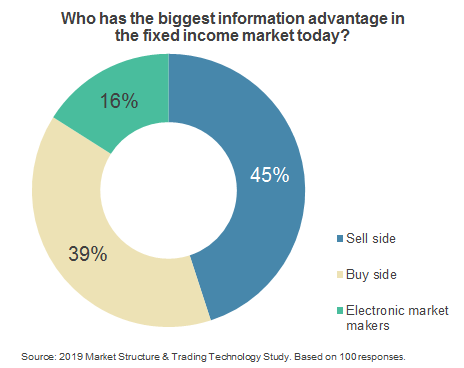
Over the years trading desks at the largest banks and broker-dealers profited not just from executing client trades, but because they had the pulse of the market. It was their job to know who was trading what, who held what, who had an interest in buying or selling and what the “right” price was for any given security. To some extent, this is still the case.
Despite the growth of electronic trading and the buy-side’s ability to do more on their own, our data continues to find that investors value the relationships they maintain with their trading counterparts.
However, it seems the sell-side’s information advantage might be eroding. We recently asked 100 U.S. fixed-income investors who they thought had the biggest information advantage today. Nearly 40% of those respondents believed that the tables had turned, and it was they who now had the information advantage.
This finding is particularly telling given this perception is not from sell side traders feeling the market has turned against them, but from investors who feel like they are in the driver’s seat.
This shouldn’t come as a surprise. Execution algorithms have been on the buy-side desktop for almost two decades, and order and execution management systems are like command centers and the accessibility of data, news and analytics is better than ever. But its more than that.
While dealers have deep insights into the activities of their clients, investors have access to all of those dealers who work with all of those clients. You can think of the former as one branch on a tree, and the latter as the entire tree.
One could argue this has always been the case. But the difference now is that technology allows the buy side to truly tap into all of the branches of the tree, and use that knowledge to make decisions about what to trade, when to trade and whom to trade with.
To be fair, another 45% of the respondents still feel the sell side remains firmly in control of the information advantage. It is hard to ignore the fact that the largest global banks have offices in every major market, have some of the best technology and have made it their business to be sure they have the best information to service their customers.
But clearly times have changed. Information is everywhere, and all market participants are learning to put it to work. Ultimately, information advantage is not about sell side versus buy side, but instead data haves and have nots.


